The Square Magnabicupolic Ring
The square magnabicupolic ring is a member of the family of 4D bicupolic rings, CRF polychora that consist of a 3-membered ring containing two cupolae and one prism or antiprism, with various pyramids and prisms filling up the remaining gaps to form a closed 4D shape. This particular example consists of a ring of two square cupolae and an octagonal prism, with 4 square pyramids and 4 triangular prisms around the side, for a total of 11 cells, 35 polygons (16 triangles, 17 squares, 2 octagons), 44 edges, and 20 vertices. It is classified under the category of wedges in Dr. Richard Klitzing's list of 4D segmentochora as octagon||square cupola (K4.105).
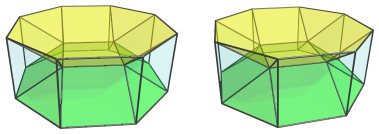
Structure
The structure of the square magnabicupolic ring is quite simple. We shall explore it using its parallel projections into 3D:
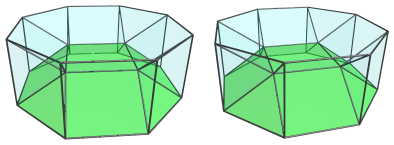
This first image shows one of the two square cupola cells. It appears slightly flattened, because it's being seen from an angle; in 4D, it has perfectly regular polygonal faces.
Here's the second square cupola, in addition to the first one:
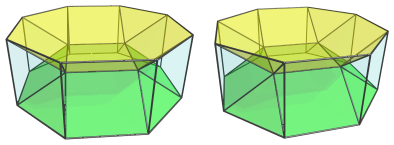
Between these two cupolae are 4 square pyramids:
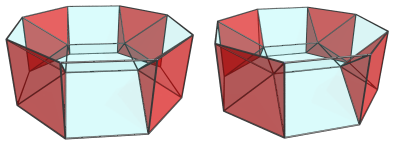
For clarity, we have omitted the square cupola cells. There are also 4 triangular prisms, which link with square pyramids to form a ring of alternating cells:
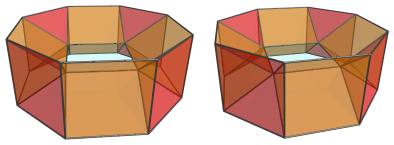
The visible square gap in the middle of the ring is where the two square cupolae meet, sharing a square face.
The outward-facing faces of these cells, together with the octagonal bases of the two square cupolae, are where they meet the last cell, the octagonal prism:
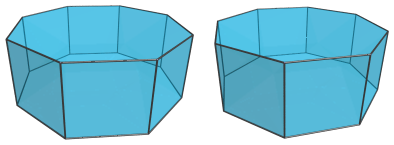
We've hidden the other cells for clarity's sake. To see more clearly how this octagonal prism is connected to the other cells, the next image shows their edge outlines:
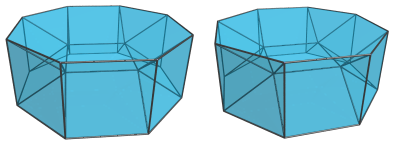
These are all the cells in the square magnabicupolic ring.
Side View
Looking at the square magnabicupolic ring's projections in the previous section from our handicapped 3D point of view, we may be misled into thinking that it a rather wide, circular shape in 4D. However, this is not accurate, because for something to be truly wide in the 4D sense, it must be wide in three directions, not just two. Here's the square magnabicupolic ring, as seen from a different 4D viewpoint:

Whoa! What happened here? Nothing strange, really. We're just looking at the same object from an angle that shows us how narrow it actually is, contrary to the impressions we may have had from looking at the previous images.
For the sake of clarity, we have omitted the cells that lies on the far side of the polytope. Here's the same view without hidden surface removal:

The octagonal prism now projects to the narrow base of the projection, as shown below:

It appears flattened, because now it is being seen from a 90° angle; but in 4D, it is still the same, perfectly uniform, octagonal prism. The green square cupola now projects to a trapezium-like shape:

Likewise with yellow cupola:

The ring of two cupolae and one octagonal prism is now clearly seen as a ring.
The ring of alternating square pyramids and triangular prisms is now orthogonal to the 4D viewpoint, and so only 3 cells are visible on the near side, two square pyramids and one triangular prism:

The remaining 2 square pyramids and 3 triangular prisms lie on the far side:

This side view of the square magnabicupolic ring shows us the rationale behind Klitzing's classification of it under the category of wedges. In 3D, it's impossible for something to be both circular and wedge-shaped at the same time; but in 4D, the extra dimension makes this possible.
Geometric Properties
A fact that may not be very obvious is that the dichoral angle (the 4D analogue of the dihedral angle) between the two square cupola cells is exactly 90°. A consequence of this fact is that the square magnabicupolic ring actually occurs as segments of the cantellated tesseract. In fact, the cantellated tesseract may be thought of as the augmentation of the 8,8-duoprism with 8 square magnabicupolic rings. The square pyramids from adjacent augments are coplanar, and merge into regular octahedra.
If two pairs of antipodal square magnabicupolic rings are cut off from the cantellated tesseract, rotated 45° in the plane of the octagonal faces, and glued back on, the result is the biparabigyrated cantellated tesseract, another CRF polychoron.
Coordinates
The Cartesian coordinates of the square magnabicupolic ring with edge length 2 are:
- (±1, ±(1+√2), ±1, 0)
- (±(1+√2), ±1, ±1, 0)
- (±1, ±1, 0, 1)




